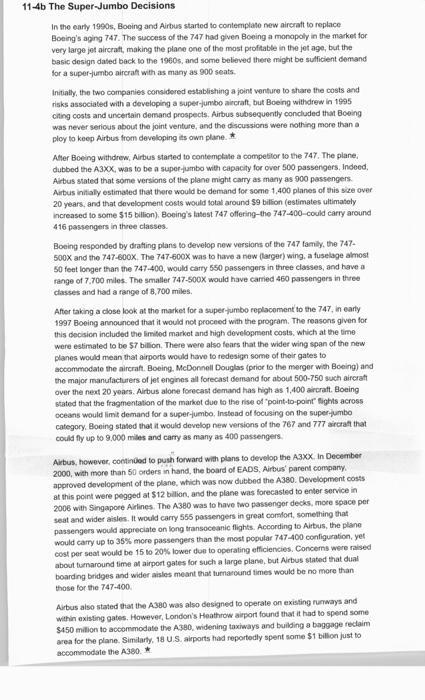Answered step by step
Verified Expert Solution
Question
1 Approved Answer
Was Boeing right to code the super jumbo market to Airbus? What factors drove Boeings decision? 11-4b The Super-Jumbo Decisions In the early 1990s, Boeing
Was Boeing right to code the super jumbo market to Airbus? What factors drove Boeing’s decision?

11-4b The Super-Jumbo Decisions In the early 1990s, Boeing and Airbus started to contemplato new aircraft to replace Boeing's aging 747. The success of the 747 had given Boeing a monopoly in the market for very large jot aircraft, making the plane one of the most profitable in the jet age, but the basic design dated back to the 1960s, and some believed there might be sufficient demand for a super-jumbo aircraft with as many as 900 seats. Initially, the two companies considered establishing a joint venture to share the costs and risks associated with a developing a super-jumbo aircraft, but Boeing withdrew in 1995 citing costs and uncertain demand prospects. Airbus subsequently concluded that Boeing was never serious about the joint venture, and the discussions were nothing more than a ploy to keep Airbus from developing its own plane. * Alter Boeing withdrew, Airbus started to contemplate a competilor to the 747. The plane, dubbed the A3X)X, was to be a super-jumbo with capacity for over 500 passengers, Indeed, Airbus stated that some versions of the plane might carry as many as 900 passengers. Airbus initially estimated that there would be demand for some 1,400 planes of this size over 20 years, and that development costs would total around $9 billion (estimates ultimately increased to some $15 billion). Boeing's latest 747 offering-the 747-400-could carry around 416 passengers in three classes. Boeing responded by drafting plans to develop new versions of the 747 family, the 747- 500X and the 747-600X, The 747-600x was to have a new (larger) wing, a fuselage almost 50 feet longer than the 747-400, would carry 550 passengers in three classes, and have a range of 7,700 miles. The smaller 747-500X would have carried 460 passengers in three classes and had a range of 8,700 miles. After taking a close look at the market for a super-jumbo replacement to the 747, in earty 1997 Boeing announced that it would not proceed with the program. The reasons given for this decision included the limited market and high development costs, which at the time were estimated to be $7 bilion. There were also fears that the wider wing span of the new planes would mean that airports would have to redesign some of their gates to accommodate the aircraft. Boeing. McDonnell Douglas (prior to the merger with Boeing) and the major manufacturers of jet engines all forecast demand for about 500-750 such aircraft over the next 20 years. Airbus alone forecast demand has high as 1,400 airoraft. Boeing stated that the fragmentation of the market due to the rise of "point-to-point fights across oceans would limit demand for a super-jumbo, Instead of focusing on the super-jumbo category, Boeing stated that it would develop new versions of the 767 and 777 aircraft that could fly up to 9,000 miles and carry as many as 400 passengers. Airbus, however, continded to push forward with plans to develop the A3XX. In December 2000, with more than 50 orders in hand, the board of EADS, Airbus' parent company. approved development of the plane, which was now dubbed the A380. Development costs at this point were pegged at $12 billion, and the plane was forecasted to enter service in 2006 with Singapore Airlines. The A380 was to have two passenger decks, more space per seat and wider aisles. It would carry 555 passengers in great comfort, something that passengers would appreciate on long transoceanic flights. According to Airbus, the plane would carry up to 35% more passengers than the most popular 747-400 configuration, yet cost per seat would be 15 to 20% lower due to operating efficiencies. Concens were raised about turnaround time at airport gates for such a large plane, but Airbus stated that dual boarding bridges and wider aisles meant that turnaround times would be no more than those for the 747-400. Airbus also stated that the A380 was also designed to operate on existing ruways and within existing gates. However, London's Heathrow airport found that it had to spend some $450 milion to accommodate the A380, widening taxiways and building a baggage reclaim area for the plane. Similarly, 18 U.S. airports had reportedly spent some $1 billon just to accommodate the A380, *
Step by Step Solution
★★★★★
3.48 Rating (151 Votes )
There are 3 Steps involved in it
Step: 1
Answer Yes Boeing was correct in entrusting the superjumbo to Airbus This de...
Get Instant Access to Expert-Tailored Solutions
See step-by-step solutions with expert insights and AI powered tools for academic success
Step: 2

Step: 3

Ace Your Homework with AI
Get the answers you need in no time with our AI-driven, step-by-step assistance
Get Started


